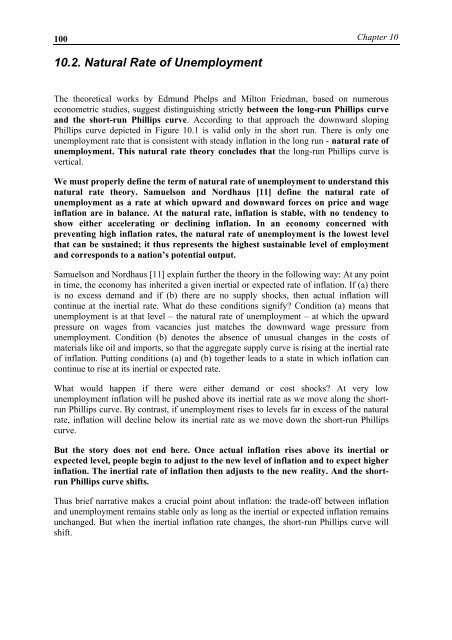MacroeconomicsI_working_version (1)
Create successful ePaper yourself
Turn your PDF publications into a flip-book with our unique Google optimized e-Paper software.
100<br />
Chapter 10<br />
10.2. Natural Rate of Unemployment<br />
The theoretical works by Edmund Phelps and Milton Friedman, based on numerous<br />
econometric studies, suggest distinguishing strictly between the long-run Phillips curve<br />
and the short-run Phillips curve. According to that approach the downward sloping<br />
Phillips curve depicted in Figure 10.1 is valid only in the short run. There is only one<br />
unemployment rate that is consistent with steady inflation in the long run - natural rate of<br />
unemployment. This natural rate theory concludes that the long-run Phillips curve is<br />
vertical.<br />
We must properly define the term of natural rate of unemployment to understand this<br />
natural rate theory. Samuelson and Nordhaus [11] define the natural rate of<br />
unemployment as a rate at which upward and downward forces on price and wage<br />
inflation are in balance. At the natural rate, inflation is stable, with no tendency to<br />
show either accelerating or declining inflation. In an economy concerned with<br />
preventing high inflation rates, the natural rate of unemployment is the lowest level<br />
that can be sustained; it thus represents the highest sustainable level of employment<br />
and corresponds to a nation’s potential output.<br />
Samuelson and Nordhaus [11] explain further the theory in the following way: At any point<br />
in time, the economy has inherited a given inertial or expected rate of inflation. If (a) there<br />
is no excess demand and if (b) there are no supply shocks, then actual inflation will<br />
continue at the inertial rate. What do these conditions signify? Condition (a) means that<br />
unemployment is at that level – the natural rate of unemployment – at which the upward<br />
pressure on wages from vacancies just matches the downward wage pressure from<br />
unemployment. Condition (b) denotes the absence of unusual changes in the costs of<br />
materials like oil and imports, so that the aggregate supply curve is rising at the inertial rate<br />
of inflation. Putting conditions (a) and (b) together leads to a state in which inflation can<br />
continue to rise at its inertial or expected rate.<br />
What would happen if there were either demand or cost shocks? At very low<br />
unemployment inflation will be pushed above its inertial rate as we move along the shortrun<br />
Phillips curve. By contrast, if unemployment rises to levels far in excess of the natural<br />
rate, inflation will decline below its inertial rate as we move down the short-run Phillips<br />
curve.<br />
But the story does not end here. Once actual inflation rises above its inertial or<br />
expected level, people begin to adjust to the new level of inflation and to expect higher<br />
inflation. The inertial rate of inflation then adjusts to the new reality. And the shortrun<br />
Phillips curve shifts.<br />
Thus brief narrative makes a crucial point about inflation: the trade-off between inflation<br />
and unemployment remains stable only as long as the inertial or expected inflation remains<br />
unchanged. But when the inertial inflation rate changes, the short-run Phillips curve will<br />
shift.




